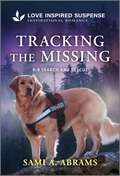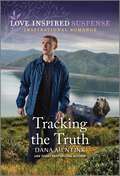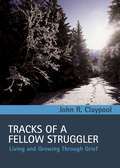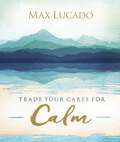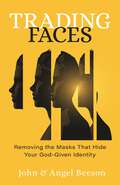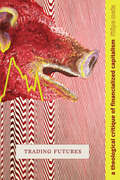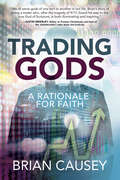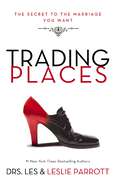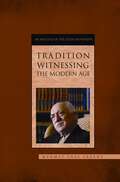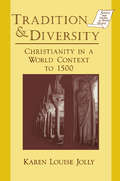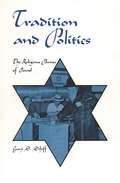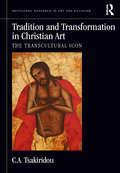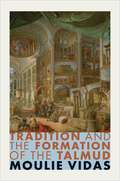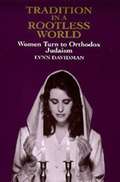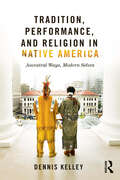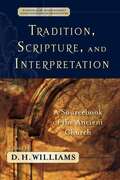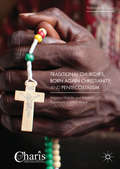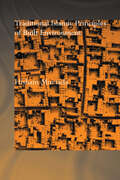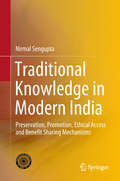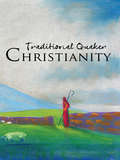- Table View
- List View
Tracking a Killer (Rocky Mountain K-9 Unit #6)
by Elizabeth GoddardCan an officer and her furry partner survive a killer and the wilderness? When Rocky Mountain K-9 officer Harlow Zane and her cadaver dog, Nell, join the search for a serial killer, the last thing she expects is that she&’ll draw the killer&’s obsessive attention. But her former academy rival, FBI Special Agent Wes Grey, notices she matches the victim profile. After another look-alike goes missing, they must work together to catch the criminal…before Harlow&’s the next to disappear. From Love Inspired Suspense: Courage. Danger. Faith. Rocky Mountain K-9 Unit Book 1: Detection Detail by Terri ReedBook 2: Ready to Protect by Valerie HansenBook 3: Hiding in Montana by Laura ScottBook 4: Undercover Assignment by Dana MentinkBook 5: Defending from Danger by Jodie BaileyBook 6: Tracking a Killer by Elizabeth GoddardBook 7: Explosive Revenge by Maggie K. BlackBook 8: Rescue Mission by Lynette Eason
Tracking the Missing (K-9 Search and Rescue)
by Sami A. AbramsA search for three abducted teens— and a K-9 on the case. After surviving a vicious attack in the woods, Tori Campbell awakes to her worst nightmare—her son and his two friends are missing. She calls the one person she knows she can trust, her late husband&’s best friend, former DEA agent Michael Lane. Together with his search-and-rescue K-9, they must track the boys and figure out who took them—and why. Only, the Indiana wilderness is full of dangers beyond their abductor. Can Michael and Tori find the teens…even if it means falling into a sinister trap?From Love Inspired Suspense: Courage. Danger. Faith.K-9 Search and Rescue Book 1: Desert Rescue by Lisa PhillipsBook 2: Trailing a Killer by Carol J. PostBook 3: Mountain Survival by Christy BarrittBook 4: Search and Defend by Heather WoodhavenBook 5: Following the Trail by Lynette EasonBook 6: Dangerous Mountain Rescue by Christy BarrittBook 7: Wilderness Hunt by Lisa PhillipsBook 8: Alaskan Mountain Search by Sarah VarlandBook 9: Alaskan Avalanche Escape by Darlene L. TurnerBook 10: Tracking Stolen Treasures by Lisa PhillipsBook 11: Alaskan Wilderness Rescue by Sarah VarlandBook 12: Lethal Mountain Pursuit by Christy BarrittBook 13: Tracking the Missing by Sami A. AbramsBook 14: K-9 Alaskan Defense by Sarah VarlandBook 15: Searching for Justice by Connie Queen
Tracking the Tiny Target
by Connie QueenCatching a kidnapper takes teamwork …and a K-9&’s help. When a three-year-old boy is kidnapped, deputy sheriff Chandler Murphy and his search-and-rescue K-9 partner are on the case. And when the child&’s mother, Bristol Delaney, insists on helping, he can&’t turn her away. But someone is dead set on stopping the investigation. Can Chandler guarantee Bristol&’s safety and rescue the missing child before the trail goes cold?From Love Inspired Suspense: Courage. Danger. Faith.
Tracking the Truth (K-9 Unit)
by Sarah Varland Sharee StoverA dangerous search for justiceAlaskan Showdown by Sarah Varland After finding the body of a missing hiker in her small Alaska town, search-and-rescue dog handler Adriana Steele becomes the target of a serial killer thought to have been inactive for decades. Now Adriana&’s determined to help Officer Levi Wicks catch the murderer. But with the cold case heating up, the jaded officer is all that stands between her and death.Cold Case Trail by Sharee Stover Temporarily working in the cold case division was supposed to mean less danger for state trooper Trey Jackson and his injured K-9 partner, Magnum—until they thwart an abduction. Now he must protect profiler Justine Stark, even as she blames him for her friend&’s death ten years ago. Can he right past wrongs by finally solving the murder…and making sure Justine lives to find closure? 2 Thrilling StoriesAlaskan Showdown and Cold Case Trail
Tracking the Truth (Security Hounds Investigations #1)
by Dana MentinkTo expose a suspect, he needs evidence… and a K-9&’s instincts. After Emery Duncan is abducted and dumped in a lake, private investigator Roman Wolfe and his bloodhound partner rescue her from an icy death. Someone doesn&’t want Emery to find out what really happened the night her father confessed to attempted murder. To keep Emery and her baby nephew safe, they must uncover the connection between her father&’s confession and the attack…or they&’ll be silenced for good.From Love Inspired Suspense: Courage. Danger. Faith.Security Hounds Investigations Book 1: Tracking the Truth
Tracks of a Fellow Struggler: How to Handle Grief (2nd Edition)
by John ClaypoolJohn Claypool had been a pastor for almost two decades, ministering to others who suffered through the loss of loved ones, when the loss came home with the death of his eight-year-old daughter. This book is the story of Claypool's own journey through the darkness, written through four sermons. The first was delivered just eleven days after his daughter's diagnosis of leukemia, the second after her first major relapse nine months later, and the third weeks after her death. The final sermon--a reflection on the process of grieving--was preached three years later.
Tracks of a Fellow Struggler: Living and Growing through Grief
by John R. ClaypoolWith over a million copies sold, one’s pastor’s personal experience with devastating grief—and learning to heal through faith—has touched countless hearts. John Claypool had been a pastor for almost two decades, ministering to others who suffered through the loss of loved ones, when loss hit home with the death of his eight-year-old daughter. In Tracks of a Fellow Struggler, Rev. Claypool shares his own journey through the darkness of heartbreaking grief through four extraordinary sermons. The first was delivered just eleven days after his daughter’s diagnosis of leukemia, the second after her first major relapse nine months later, and the third weeks after her death. The final sermon—an inspiring reflection on the process of grieving—was preached three years later. Loss is something we must all cope with, and one of the greatest spiritual challenges is sustaining faith when life seems most unfair, sometimes tragic. With a depth of compassion born of his own personal experience, the author of Mending the Heart brings emotional comfort and spiritual strength to anyone who has suffered the loss of a loved one.
Trade Your Cares for Calm
by Max LucadoBe Free from the Worries That Weigh You Down.If you’re trembling on a tightrope of fear and worry, get ready for the best trade ever: your cares for God’s calm.What if faith, not fear, could be your default reaction to circumstances? Imagine being able to walk away from worry, conquer the need to control, get rid of guilt, and end if-only thinking.That’s God’s offer. He wants to exchange your burdens for an abundance of mercy, gratitude, and trust. To replace striving and stress with a faith-filled life in which you’ll see God’s goodness, feel calm in chaos, and find peace through prayer.Bestselling author Max Lucado understands what it’s like to feel overwhelmed by anxiety. Through unforgettable stories and biblical wisdom, he offers powerful tools to help you manage your fears and worries.
Trading Faces: Removing the Masks that Hide Your God-Given Identity
by John Beeson Angel BeesonA biblical and practical guide on how to replace false identities with the healthy truthSeeking fulfilment, many Christians turn to identities that promise to give their lives meaning: profession, roles as spouse or parent, personality types, even sexuality--anything that can be held up to others as the empowering core of who they are. But when these new labels don’t give them any real foundation for hope, they end up feeling disappointed, directionless, and defeated. Those false identities turn out to be only sand.John and Angel Beeson have seen this problem again and again in their respective roles as pastor and counselor. And they want searching Christians to know the truth: a fulfilling understanding of self can only be found by rooting one's identity in the unchangeable and nonnegotiable understanding of who we were created to be.This husband-and-wife team considers ten identities that masquerade as truth and challenge readers to trade those labels for the ones Christ offers. They explain why true identity matters, how our masks can suffocate us, and how substitute identities can become idolatry. They share real struggles from real people. And they offer hope in a comprehensive index of our identities in Christ, both individual and the collective identity of the church.
Trading Futures: A Theological Critique of Financialized Capitalism
by Filipe MaiaThe discourse of financialized capitalism tries to create a future predictable enough to manage risk for the wealthy, to shape the future into a profit-making site that constrains and privatizes the sense of what’s possible. Here, people’s hopes and meaning-making energies are policed through the burden of debt. In Trading Futures Filipe Maia offers a theological reflection on hope and the future, calling for escape routes from the debt economy. Drawing on Marxism, continental philosophy, and Latin American liberation theology, Maia provides a critical portrayal of financialization as a death-dealing mechanism that colonizes the future in its own image. Maia elaborates a Christian eschatology of liberation that offers a subversive mode of imagining future possibilities. He shows how the Christian vocabulary of hope can offer a way to critique the hegemony of financialized capitalism, propelling us in the direction of a just future that financial discourse cannot manage or control.
Trading Gods: A Rationale for Faith
by Brian CauseyA man recounts his investigation into spirituality and into what he really believed about religion following the September 11th terrorist attacks.Suddenly, Brian Causey found himself stumbling over life’s greatest questions: Why are we here? How did the universe and life begin? Why is there suffering in the world? What happens after we die? If there is an afterlife, how do I get there?A portfolio manager at a large investment company, Brian would leave the trading floor each day with these questions swirling in his head. What he came to realize was that he had to make a decision: would he trade the god he had been following, under which he could make his own rules, without subscribing to any larger organization or authority?for the “real” God? The more he researched the difficult questions of life; the clearer God’s truth became. Brian ultimately concluded that the evidence points in the direction of God’s existence. In Trading Gods, he shares his personal journey, rationale for faith, and the supporting research that explains why the real God is the best answer to life’s biggest questions.“We all serve gods of one sort or another in our life. Brian’s story of being a trader who, after the tragedy of 9/11, found his way to the true God of Scripture, is both illuminating and inspiring.” —Justin Brierley, editor at Premier Christianity and host of the Unbelievable? radio show and podcast“For both Christian and non-Christian alike, I encourage you to take this journey with Brian. You won’t regret it!” —Nate Sala, president, A Clear Lens
Trading Places: The Best Move You'll Ever Make in Your Marriage
by Parrott LesTo understand your spouse you’ve got to walk in his or her shoes. Ever feel like you’re stepping on each other’s toes? Then maybe it’s time you put yourselves in each other’s shoes. Of course that may sound uncomfortable. But it’s easier than you think—and it will revolutionize your relationship. In fact, bestselling authors Drs. Les and Leslie Parrott reveal the little-known secrets of putting the time-tested strategy of trading places to work in your own marriage. In this book, chock-full of practical helps and tips you’ve never thought of, you’ll learn the three-step-strategy to trading places and, as a result, you’re sure to: · Increase your levels of passion · Bolster your commitment · Eliminate nagging · Short-circuit conflict · Double your laughter · Forgive more quickly · Talk more intimately In short, you’ll be more understanding and better understood. In other words, you’ll experience—day after day—the unconditional love every couple longs for. “We’ve often fantasized about being able to literally hand a box of mutual empathy—the revolutionary tool for instantly improving a relationship—to the couples that attend our seminars. Well, this book is the closest we’ll ever come to being able to do just that.” --Les and Leslie Parrott Most couples never discover the rewards of trading places. For example, did you know it’s the quickest way to get your own needs met? It’s true! And Les and Leslie show you how. They also disclose exactly how trading places improves your conversations and how it’s guaranteed to fire up your sex life. Truly, your love life and your entire marriage will never be the same after you learn the intimate dance of trading places. This book also features a powerful, free online assessment, powered by eHarmony Marriage that instantly improves your inclination to trade places. How? By zeroing in on exactly what you’d most like your spouse to accurately understand about you. In addition, two workbooks with no-nonsense exercises—one for you and one for your spouse—will help you apply each chapter to your own marriage. Les and Leslie have made it easy. So why not walk a few steps in your spouse’s shoes, starting today? Whether you’re a newlywed couple or you’ve been married for decades, it’s never too early or too late to attain the power of trading places.
Tradition Witnessing The Modern Age
by Enes ErgeneAddressing the sociological, cultural, and religious aspects of the Glen movement, this insider&’s look also explores the failure experienced by many other Islamic movements that attempted to combine traditional values with the modern world. The influence Fethullah Glen has had on secularist Turkey is also examined.
Tradition and Diversity: Christianity in a World Context to 1500 (Sources And Studies In World History Ser.)
by Karen Louise JollyThis text is designed to serve as a primary source reader. It addresses medieval Christendom in the context of world history. It combines the traditional approach (the medieval Christian tradition found in the church hierarchy and theological development) with the newer approach to cultural diversity - diversity within European Christianity (women mystics, heretics, and popular religion), and diversity without, in a world context (non-European Christianity and relations with Islam, Judaism, and Buddhism).
Tradition and Transformation in Christian Art: The Transcultural Icon (Routledge Research in Art and Religion)
by C.A. TsakiridouTradition and Transformation in Christian Art approaches tradition and transculturality in religious art from an Orthodox perspective that defines tradition as a dynamic field of exchanges and synergies between iconographic types and their variants. Relying on a new ontology of iconographic types, it explores one of the most significant ascetical and eschatological Christian images, the King of Glory (Man of Sorrows). This icon of the dead-living Christ originated in Byzantium, migrated west, and was promoted in the New World by Franciscan and Dominican missions. Themes include tensions between Byzantine and Latin spiritualities of penance and salvation, the participation of the body and gender in deification, and the theological plasticity of the Christian imaginary. Primitivist tendencies in Christian eschatology and modernism place avant-garde interest in New Mexican santos and Greek icons in tradition.
Tradition and the Formation of the Talmud
by Moulie VidasTradition and the Formation of the Talmud offers a new perspective on perhaps the most important religious text of the Jewish tradition. It is widely recognized that the creators of the Talmud innovatively interpreted and changed the older traditions on which they drew. Nevertheless, it has been assumed that the ancient rabbis were committed to maintaining continuity with the past. Moulie Vidas argues on the contrary that structural features of the Talmud were designed to produce a discontinuity with tradition, and that this discontinuity was part and parcel of the rabbis' self-conception. Both this self-conception and these structural features were part of a debate within and beyond the Jewish community about the transmission of tradition.Focusing on the Babylonian Talmud, produced in the rabbinic academies of late ancient Mesopotamia, Vidas analyzes key passages to show how the Talmud's creators contrasted their own voice with that of their predecessors. He also examines Zoroastrian, Christian, and mystical Jewish sources to reconstruct the debates and wide-ranging conversations that shaped the Talmud's literary and intellectual character.
Tradition in a Rootless World: Women Turn to Orthodox Judaism
by Lynn DavidmanRecently, some women have turned away from the myriad, complex choices presented by modern life and chosen instead a Jewish Orthodox tradition that defines women's roles primarily in terms of their duties as wives and mothers in nuclear families.
Tradition, Performance, and Religion in Native America: Ancestral Ways, Modern Selves
by Dennis KelleyIn contemporary Indian Country, many of the people who identify as "American Indian" fall into the "urban Indian" category: away from traditional lands and communities, in cities and towns wherein the opportunities to live one's identity as Native can be restricted, and even more so for American Indian religious practice and activity. Tradition, Performance, and Religion in Native America: Ancestral Ways, Modern Selves explores a possible theoretical model for discussing the religious nature of urbanized Indians. It uses aspects of contemporary pantribal practices such as the inter-tribal pow wow, substance abuse recovery programs such as the Wellbriety Movement, and political involvement to provide insights into contemporary Native religious identity. Simply put, this book addresses the question what does it mean to be an Indigenous American in the 21st century, and how does one express that indigeneity religiously? It proposes that practices and ideologies appropriate to the pan-Indian context provide much of the foundation for maintaining a sense of aboriginal spiritual identity within modernity. Individuals and families who identify themselves as Native American can participate in activities associated with a broad network of other Native people, in effect performing their Indian identity and enacting the values that are connected to that identity.
Tradition, Scripture, and Interpretation: A Sourcebook of the Ancient Church (Evangelical Ressourcement)
by D. H. WilliamsTradition, Scripture, and Interpretation supplements a valuable series that helps modern church leaders return to the wisdom and insight of the early church fathers in order to apply their ancient understandings of Christian belief and practice to ministry in the twenty-first century. This sourcebook gathers key writings from the first through sixth centuries on various topics of concern to the church yesterday and today. The writings are arranged thematically, and within each theme, chronologically, revealing how the Christian tradition on a given topic developed over time. The anthology begins with a chapter examining the close relationship between Scripture and tradition in the minds of early church leaders.
Traditional Churches, Born Again Christianity, and Pentecostalism: Religious Mobility and Religious Repertoires in Urban Kenya (Christianity and Renewal - Interdisciplinary Studies)
by Yonatan N. GezIn Kenya's vibrant urban religious landscape, where Pentecostal and traditional churches of various orientations live side by side, religious identity tends to overflow a single institutional affiliation. While Kenya’s Christianity may offer modes of coping with the fragilities of urban life, it is subject to repeated crises and schisms, often fueled by rumors and accusations of hypocrisy. In order to understand the unfolding of Kenyans’ dynamic religious identities, and inspired by the omnipresent distinction between ‘religious membership’ and ‘church visits,’ Yonatan N. Gez considers the complementary relations between a center of religious affiliation and expansion towards secondary practices. Building on this basic distinction, the book develops a theoretical innovation in the form of the ‘religious repertoire’ model, which maps individuals’ religious identities in terms of three intertwined degrees of practice.
Traditional Islamic Principles of Built Environment
by Hisham MortadaWritten with the non-Muslim reader in mind, this book analyses the principles and values established by Islamic tradition to govern the social and physical environments of Muslims.The picture of Islam that emerges from this work is of a way of life with social ideals. Relying on the Qur'an and Sunna, the basic sources of Islamic law, and using examples of the built environment of early Muslims in North Africa, the Middle East, Europe and Central Asia, the author explains how following these ideals can create an urban environment that responds to social and environmental variables.Islamic views on the controversial issue of modernisation are also examined.This book will be of interest to people in the fields of urban planning, architecture, sociology, anthropology, housing and built environment, as well as Islamic studies.
Traditional Knowledge in Modern India: Preservation, Promotion, Ethical Access and Benefit Sharing Mechanisms
by Nirmal SenguptaThis book demonstrates how traditional knowledge can be connected to the modern world. Human knowledge of housing, health and agriculture dates back thousands of years, with old wisdom developing and becoming modern. But in the past few decades, global communities have increasingly become aware that some of this valuable knowledge has fallen by the wayside. This has sparked systematic efforts at the local, national and global levels to connect this neglected knowledge to the modern world.It discusses the origin of the topic, its importance, recent developments in India and abroad, and what is being done and still needs to be done in order to preserve India’s traditional knowledge. The discussions address a broad range of fields and organizations: from Basmati rice to Ayurvedic cosmetics; from traditional irrigation and folk music to modern drug discovery and climate change adaptation; and from the Biodiversity Convention to the WHO, WTO and WIPO.
Traditional Logic Book I: Introduction To Formal Logic
by Martin CothranThis book discusses traditional logic rather than modern logic. Traditional logic is the study of the classical syllogism; modern logic is the study, primarily, of the calculus of propositions.
Traditional Quaker Christianity
by Susan Smith Terry Wallace John 'Jack' Smith Arthur BerkDo Quakers really worship in silence? Why don't they plan their worship services beforehand? Why do Friends make decisions on church business without voting? Can I know Jesus, guiding and teaching me? Where does true peace come from? Traditional Quaker Christianity offers the reader a means to explore the time-honored faith of Friends (Quakers), describes how modern-day Conservative Friends put that faith into everyday practice, and outlines the reasons for many of Friends' distinctive ways. The book's purpose is to assist people seeking a living faith in Christ Jesus, Who is present and powerful in the midst of all His people. Traditional Quaker Christianity can be useful not only to the individual seeker, but also as a study guide for small groups of new Friends and long-time Quakers seeking to go deeper in their spiritual pilgrimage. Several questions at the end of each section help readers relate the material to their own lives and provide a starting point for discussion.

